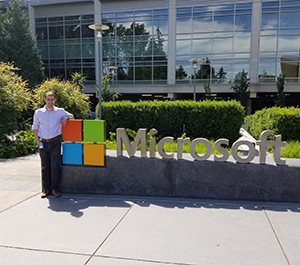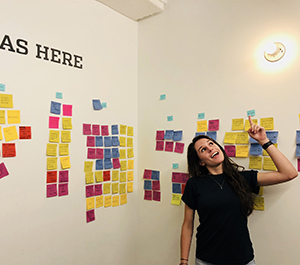EDI Students Reflect on Internships
Students explored CPG, Tech, Healthcare, and Service Design
During the summer term, graduate students in the Master of Science in Engineering Design Innovation (EDI) program participate in design industry internships around the country. The internship experience can help an EDI student focus their passion for design innovation to a specific field or potentially lead to a job following graduation.
This past summer, EDI students interned at AT&T, Blue Cross Blue Shield Association, Feeding America, U.S. Department of Health and Human Services, Microsoft, Procter & Gamble Ventures, and United Airlines among others.
Continue reading for the perspectives of four EDI ‘18 students.
 Chris Datsikas, Intern - Microsoft
Chris Datsikas, Intern - Microsoft
What drew you to an internship in the tech industry?
CD: I am passionate about understanding user needs, tackling technical challenges, and scoping business opportunities in order to deliver human-centered experiences that assist, connect, and empower people. The tech industry provides one of the best ecosystems to practice this. I am humbled by the opportunity technology provides to solve difficult challenges with enormous impact.
What did you hope to gain from your internship experience this summer?
CD: First, to gain experience in defining the "what" and the "why" in a real-world product management setting. This also meant adapting EDI learnings into a corporate environment. Second, to meet and learn from as many people as possible, including other interns, mentors, and company leaders.
Was there a particular course that you found yourself drawing on during your internship?
CD: The human-centered design process, which was solidified for me in Greg Holderfield's Design Strategy course [during which the students partnered with iRobot]. That course provided an incredibly valuable toolkit that I constantly applied throughout the internship.
What did you primarily work on during your internship?
CD: This summer, I investigated if and how Microsoft products should interoperate with a variety of meeting room devices. There were two parts to the work that I really enjoyed. First, I got to interact with a wide variety of stakeholders including PMs, designers, marketing experts, and strategists to better understand and analyze the space. Second, I enjoyed the emphasis on synthesizing quantitative and qualitative data to make decisions.
 Morgan Lewis, Intern - P&G Ventures
Morgan Lewis, Intern - P&G Ventures
What drew you to an internship in the CPG industry?
ML: I like working with physical products and paying attention to every little detail of the entire user experience.
What did you hope to gain from your internship experience this summer?
ML: I wanted to get more practice on the entire design process to help me figure out with part of it I am drawn to the most in order to help guide me to what I want to do once I graduate from EDI. I also wanted to get a taste for what it's like to do these types of projects in a work environment rather than a classroom.
Was there a particular course that you found yourself drawing on during your internship?
ML: Our first EDI design class with P&G [taught by Helen von den Steinen and Jim Wicks] was definitely useful and relevant along with the CPG class taught by Helen von den Steinen and Craig Sampson that was the seed for this internship. I found myself using skills learned throughout both of the classes having to do with every part of the design process.
What did you primarily work on during your internship?
ML: Since I was on a small team of three, trying to create an entire brand and portfolio of products, I worked on everything, from consumer interviews to ideation, to prototyping, to mocking up and testing a website, etc.
Beth Lester, Intern - U.S. Department of Health and Human Services
What drew you to an internship in the healthcare industry?
Actually, I didn’t necessarily want to do something in the public sector, but I did want to do something that helped people, specifically with regards to health and wellness/well-being. Whether that meant working in healthcare or more broadly in non-profit type positions, I did not have a preference.
What did you hope to gain from your internship experience this summer?
BL: I wanted to get experience doing design research and strategy within these fields during my internship.
Was there a particular course that you found yourself drawing on during your internship?
BL: It was definitely a culmination of all of them.
What did you primarily work on during your internship?
BL: I spoke with state-level directors and commissioners, private sector workers, and a smattering of other state employees within the areas of government assistance programs. We worked to develop
 Lydia Davison, Intern - Feeding America
Lydia Davison, Intern - Feeding America
What drew you to an internship in the service design field?
LD: This summer, I worked as an Innovation Intern at the Feeding America National Office. For Service Design this past year, our cohort partnered with Feeding America and I had a wonderful time. During my undergraduate degree, I wasn’t explicitly exposed to service design, so I wanted to take the internship opportunity provided through the structure of the EDI program to further explore service design and continue to practice service design. Additionally, I was interested in the power that human-centered design can have within the social impact space and how it can be applied within a complex, multi-faceted space.
What did you hope to gain from your internship experience this summer?
LD: I was able to witness first hand how impactful and meaningful the project, work, and organization of Feeding America is through our partnership this past winter. Even through prototyping really dinky foam core mockups, we were able to feed others and improve their lives. I’m interested in working on projects that truly matter and have the potential to positively impact people and communities. Additionally, I was very excited to continue to learn from Dan Butt and Maura Shea. They both have very rich and diverse backgrounds that they apply to their work in exciting and interesting ways. I’m interested in continuing to practice conducting fieldwork and research and continue to iterate on prototypes for the purpose of growing as a designer and researcher.
Was there a particular course that you found yourself drawing on during your internship?
LD: For me, Service Design [taught by Amy O'Keefe and Elisa Vargas] was incredibly helpful as I found myself drawing on skills we built over the quarter, like blueprints. I also relied on some of the research and understandings that my team and I developed over winter term while working on our service design project for Feeding America. I also found myself drawing upon the intentionality and methodologies that I practiced during Interaction Design [taught by Haoqi Zhang] as well as the desirability, feasibility, and viability techniques that I studied during Design Strategy plus the creativity and exploration that I was inspired by during Design Research [taught by Michael Chapman and Murphy MacDonald] in the fall term.
What did you primarily work on during your internship?
LD: I worked on exploring new ways for the Feeding America network to provide food to people who are food insecure, but not currently accessing food pantries or food banks for various reasons. The Innovation team conducted a slew of in-context interviews and observation before my summer arrival, which allowed me the opportunity to explore prototypes and experiments with them during the summer. I spent the first portion of my internship constructing prototypes and thinking through how to execute experiments with the Innovation team. I was then able to continue to iterate on our prototypes and ideas while beginning to explore the feasibility and viability aspects of the ideas with the Innovation team.

